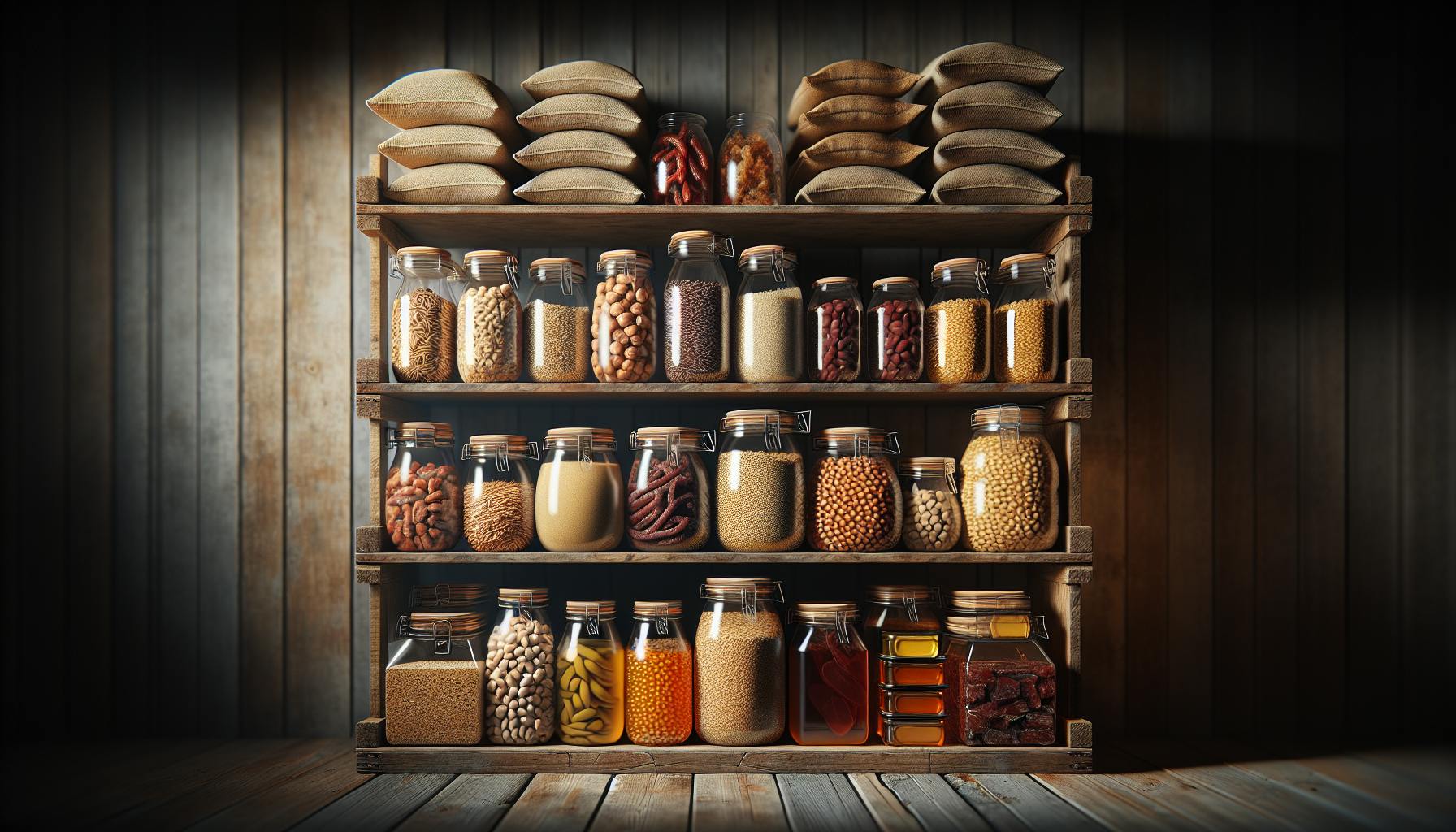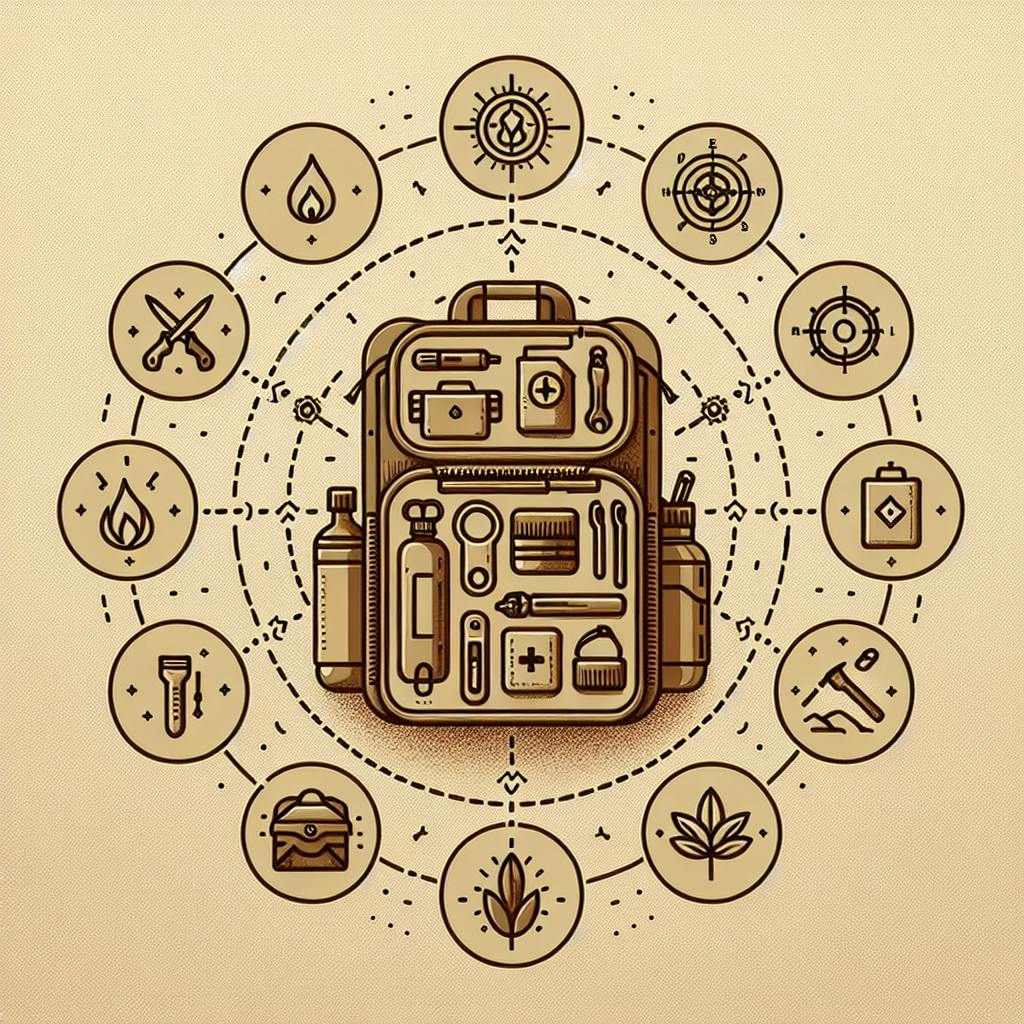When packing for a camping trip, we can all agree that food is a critical component for survival and energy in the wilderness.
With the right selection of lightweight, nutritious, and convenient camping food essentials, you can build a survival kit tailored to your exact nutritional needs and adventure.
In this article, we'll explore must-have camping survival foods across categories like proteins, fruits and vegetables, fats, and more. You'll discover practical tips for storage, preparation, calculating daily calories, and customizing your personal camping food supply.
Introduction to Camping Survival Food Essentials
When heading out into the wilderness for camping or survival scenarios, having the right food is essential. The key is packing nutrient-dense foods that have a long shelf life and are easy to prepare when minimal cooking facilities are available. This guide will provide an overview of building a well-rounded food survival kit, understanding nutritional needs for maintaining health, leveraging convenient ready-to-eat options, proper storage/preservation, and customizing your supplies to suit your situation.
Building Your Food Survival Kit for the Outdoors
Start with a basic foundation of staples like trail mix, protein bars, jerky, and freeze-dried fruit/veg. Carbohydrate-rich snacks offer quick energy, while protein keeps you feeling fuller between meals. Consider adding compact, ready-to-eat meals like MREs or canned goods for convenience. Dried pasta/rice, oats, spices, oil, and condiments allow you to prepare simple campfire recipes. Round out your kit with foraged foods like wild berries when possible.
Understanding Nutritional Needs in Survival Scenarios
In survival mode, focus on maintaining energy levels through complex carbs and protein while keeping electrolytes/vitamins up. Pack familiar comfort foods for morale. Estimate 2,000 calories per person daily, with higher needs for children/high activity. Balance macros, prioritizing energy-dense but lightweight options. Stay vigilant about hidden deficiencies from lack of fresh produce.
The Role of Convenience: Ready Hour Freeze-Dried Food and More
Ready-to-eat survival foods offer quick, no-fuss meals in the wild. Products like Ready Hour excel due to long shelf lives up to 25 years, compact packaging, balanced nutrition with familiar flavors, and the ability to be eaten straight from the pouch. While convenient, they can get pricey for extended trips. Balance with homemade trail mix and dehydrated ingredients.
Storage and Preservation of Camping Survival Food
Proper storage is key to avoiding spoilage/contamination and ensuring gear longevity. Use airtight, waterproof containers suited for backcountry use. Stash in cool, dark areas away from critters. Separate cooking equipment to prevent cross-contamination. Routinely check supplies for expiration/pest damage. Practice FIFO by rotating stock.
Customizing Your Kit: The Best Camping Survival Food for You
Tailor your food kit to your group's tastes, restrictions, durations, etc. Lightweight backpackers may rely more on compact, calorie-dense options with minimal prep needed, while base campers can afford bulkier ingredients to create heartier campfire meals. There is no one-size-fits-all solution. Test options at home to find your go-to survival foods before an emergency.
Essential Camping Survival Food Items
Camping survival food is crucial for maintaining health and energy when outdoors. When packing food for emergency situations, it's important to have a balanced mix of macronutrients.
The Importance of Protein: Canned Meats and Camping MRE Meals
Protein foods like canned meats and Camping MRE meals provide sustained energy and help maintain muscle mass. Canned chicken, tuna, salmon, and beef are shelf-stable options. MREs or Meals Ready-to-Eat contain entrees like chili, pasta, and rice dishes. These portable protein sources are important when activity levels are high.
Carbohydrates for Energy: Grains and Starches
Complex carbs from grains, rice, pasta, and dehydrated potatoes supply the body with glucose. These high-energy foods can be stored for long periods. Include crackers, cereals, instant rice/potatoes, and freeze-dried pasta meals. Carbs boost energy, which is vital when hiking or doing other outdoor activities.
Maintaining Health with Fruits and Vegetables
Freeze-dried fruits and vegetables provide vitamins, minerals, and fiber. They aid digestion and support the immune system. Stock up on a variety, like broccoli, carrots, apples, and blueberries. Despite their lightweight nature, they offer nutritional benefits.
Fats for Sustained Caloric Intake: Nuts, Seeds, and Oils
Foods high in fats like nuts, seeds, nut butters, and oils are calorie-dense. This makes them useful for storing energy. Stock up on almonds, walnuts, chia seeds, peanut butter packets, and olive oil. The vitamins and minerals they provide also support bodily functions.
Hydration and Electrolytes: Powders and Supplements
Maintaining fluid and electrolyte balance is essential when active outdoors. Pack electrolyte drink mixes and supplements containing sodium, potassium and magnesium. These dissolve into water to create rehydrating beverages. Staying hydrated boosts energy and focus.
sbb-itb-b932644
Pre-Packaged Camping Survival Food Kits
Pre-packaged camping survival food kits provide convenience and practicality for outdoor adventures. These kits are designed for different durations, calorie needs, and taste preferences.
Choosing the Right Camping Survival Kit for Your Adventure
When selecting a survival food kit, consider the length of your trip, number of people in your group, expected calorie expenditure from activities, and dietary preferences. Short 1-3 day hikes may only require compact pouches, while weeklong excursions call for more substantial meal reserves. Gauge average calorie burn from the intensity of hiking, climbing, etc. to inform your choice.
The Versatility of Survival Food Pouches in the Wilderness
Survival food pouches offer lightweight, nutrient-dense and easy to prepare options perfect for short camping trips. Their compact size takes up little pack space. Favorites like freeze-dried meals, powdered sports drinks, high-calorie bars, and no-cooking-required tuna packs provide energy without extra tools or cleanup.
Long-Term Solutions: 4-Week Survival Food Kit
For multi-week wilderness trips, a complete 4-week survival food kit gives peace of mind. These robust kits contain breakfasts, lunches, dinners and snacks to fully sustain energy and nutrition for a month. Options accommodate common diets with gluten-free, diabetic-friendly and vegetarian offerings. The longer shelf life ensures less waste as well.
The Role of Camping MRE Meals in Your Food Reserves
MREs (Meals Ready to Eat) play a key role for campers needing convenient, transportable and non-perishable food. MREs contain entrees like pasta or rice dishes, side dishes, desserts and snacks. Heating packets make for warm, satisfying meals. MREs provide energy and essential micro/macronutrients for active days outside.
Specialized Nutritional Needs: Gluten-Free, Vegan, and Allergen-Friendly Options
Many pre-made survival food kits now cater to specialized diets like gluten/dairy-free, vegan/vegetarian, peanut/tree nut-free, etc. Carefully read nutrition labels and product details to find camping foods meeting your unique dietary needs. This ensures you can stay safe, healthy and energized regardless of restrictions.
Practical Tips for Managing Your Camping Survival Food Supply
Managing your food supply is critical when camping to ensure you have enough nutrition to power through your outdoor adventures. Here are some key strategies:
Calculating Your Daily Caloric Needs in the Field
- Estimate your basal metabolic rate (BMR) based on your height, weight, age and gender. Add calories for any hiking, climbing, etc. you'll be doing.
- On average, campers need 16-20 calories per pound per day. Adjust up or down depending on activity level.
- Tools like online BMR calculators can help estimate your calorie needs. Tracking your intake over time also helps refine estimates.
Food Rotation and Consumption: Avoiding Waste
- First in, first out - Use oldest food items first to avoid spoilage and waste.
- Pre-portion items to match daily needs. Resealable pouches or containers help control servings.
- Leftover perishables like freeze-dried eggs can often be safely resealed and eaten the next day.
Cooking and Preparation Techniques in the Wild
- Focus on no-cook or quick-cook options - they require minimal fuel and prep time.
- MRE meals, survival food pouches and freeze-dried foods just need hot water.
- Invest in a portable backpacking stove, lightweight cookset, and insulated mugs.
Packing and Portability: Optimizing Your Camping Survival Kit List
- Calculate total calories needed for the trip duration and pack accordingly. Leave a buffer for delays/emergencies.
- Repackage food into lightweight, portioned pouches to save space and weight.
- Use waterproof stuff sacks, bins and bags to keep food protected and organized.
Emergency Preparedness: Beyond the Basics
- Always pack backup food like survival bars or MREs for emergencies.
- Consider including foraging tools like snares to obtain backup food from the wilderness.
- Have an emergency plan for rationing food, locating water sources, etc. if extended delays occur.
Following these practical tips will help you effectively manage your camping survival food supply. Calculate needs, utilize proper storage methods, employ efficient cooking techniques, and pack backup reserves. This will ensure you get the fuel you need for every outdoor adventure.
Conclusion: The Essentials of Camping Survival Food Preparedness
When planning for camping survival, having the right food is crucial. Here are some key takeaways to ensure you select and prepare nourishing, resilient food supplies for your outdoor adventures:
Recap of Camping Survival Food Essentials
- Focus on camping survival food that is lightweight, nutrient-dense, and has a long shelf life. Items like freeze-dried meals, MREs, and survival food pouches are ideal.
- Properly store your food survival kit to protect it from temperature changes, pests, and moisture. Use airtight, waterproof containers.
- Personalize your food selection based on dietary needs, number of days in the wilderness, and types of activities planned.
- Rotate and replace food items before their expiration date to maintain freshness and nutritional quality.
Final Thoughts on Building a Resilient Food Survival Kit
Creating a well-stocked, resilient camping survival food supply takes research and planning. Focus on nutrient density, sufficient calories, and shelf life when selecting items. Consider packing ready-to-eat options like MREs as well as items that require cooking. Finally, store items properly and replace expired or opened food. With the right survival food packed, you can focus on enjoying your outdoor adventure knowing you have reliable, nourishing meals on hand if needed.


